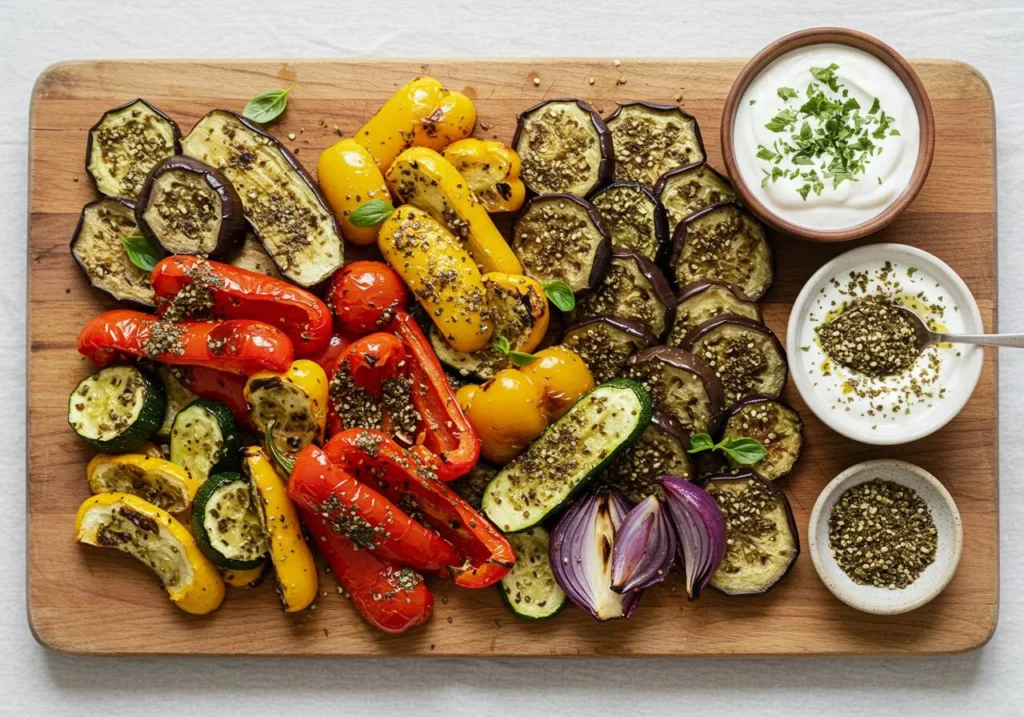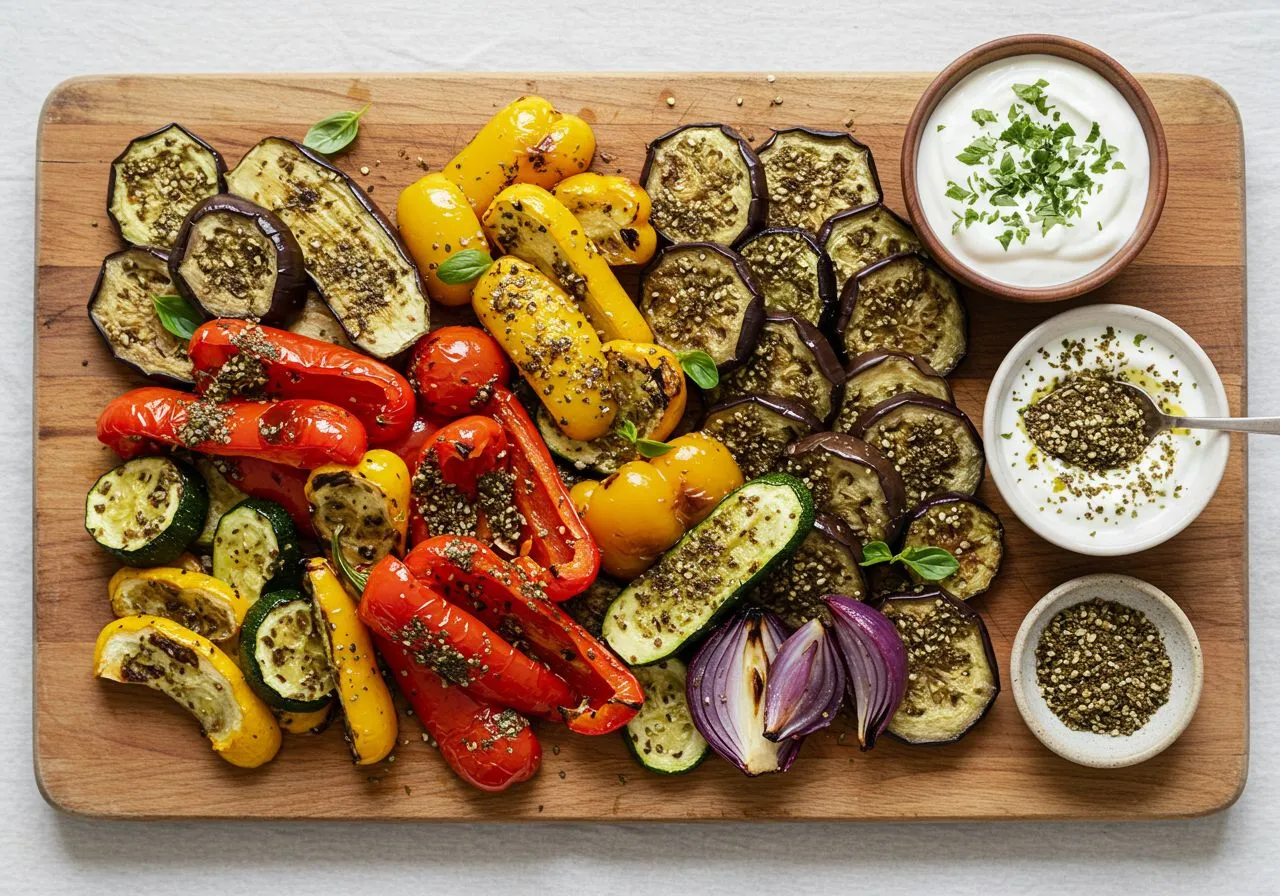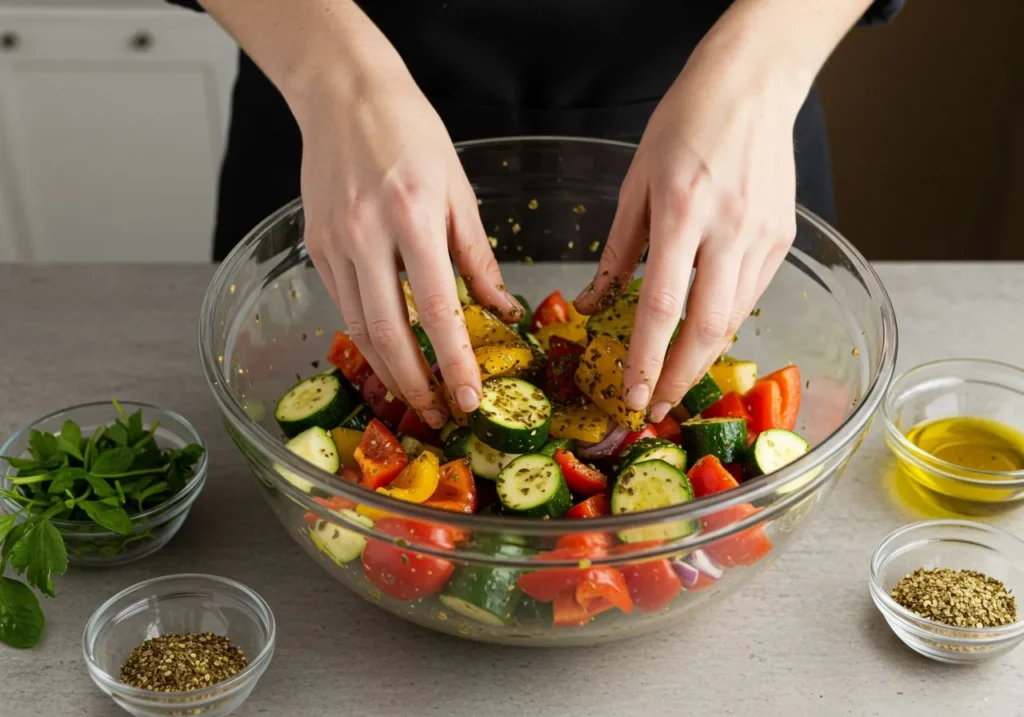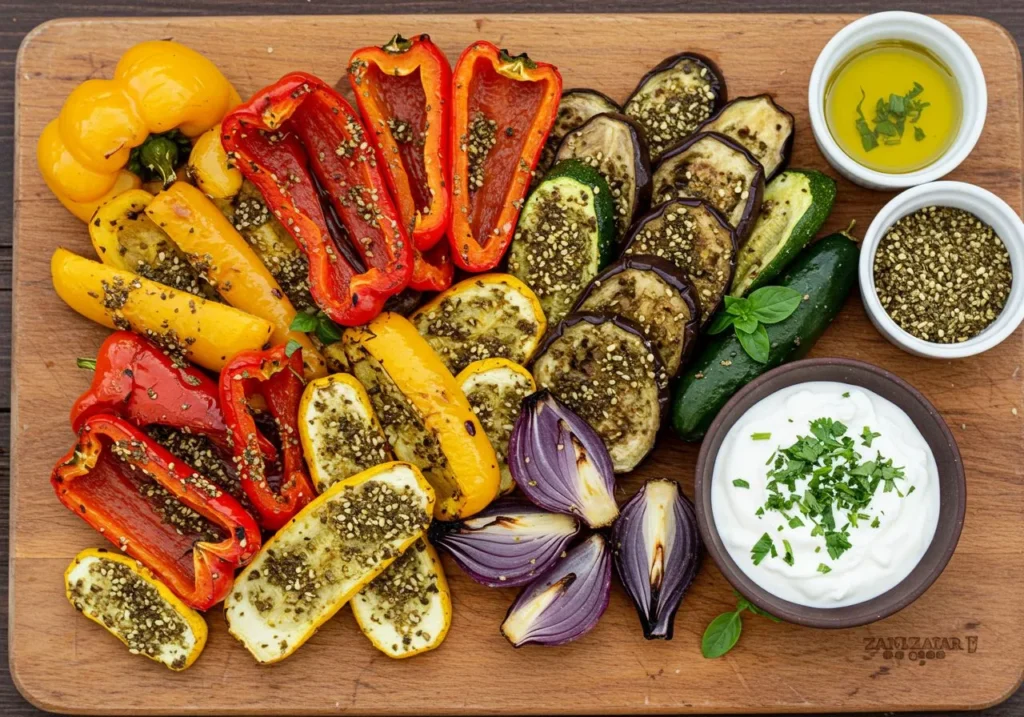
Table of Contents
Published: January 2025 | Prep Time: 15 minutes | Cook Time: 35 minutes | Serves: 6
The first time my American neighbor Jennifer tasted za’atar-roasted vegetables at our family barbecue, she literally asked me to write down the recipe on a napkin. “What IS that amazing spice?” she kept asking, as she went back for thirds of what she thought would be “just plain roasted vegetables.” I couldn’t help but smile – za’atar has that effect on people. Once you taste vegetables transformed by this magical Middle Eastern spice blend, regular roasted vegetables just seem… ordinary.
This recipe for Za’atar Roasted Vegetables with Yogurt Sauce has become my secret weapon for converting vegetable skeptics into enthusiastic fans. The za’atar creates an aromatic crust that makes everyday vegetables taste exotic and exciting, while the cool yogurt sauce provides the perfect creamy contrast. It’s become my most requested side dish and the recipe I’m most proud to share.
What I love most about this dish is how it bridges my Lebanese heritage with my American lifestyle. Za’atar, which has been seasoning Middle Eastern vegetables for thousands of years, transforms humble American grocery store vegetables into something truly special. It’s healthy, colorful, absolutely delicious, and impressive enough for company while being simple enough for weeknight dinners.

Za’atar Roasted Vegetables with Yogurt Sauce
Transform ordinary vegetables with za’atar, the aromatic Middle Eastern spice blend, and a cool, creamy yogurt sauce. This healthy, flavorful, and colorful side dish is perfect for family dinners or dinner parties.
Ingredients
Instructions
- 1Preheat oven to 425°F. Cut vegetables to uniform size. Salt eggplant to reduce bitterness, if desired.
- 2Combine vegetables with olive oil, salt, pepper, and za’atar. Toss to coat evenly.
- 3Spread vegetables in a single layer on baking sheets to avoid overcrowding.
- 4Roast for 15 minutes, toss, then roast for another 10–20 minutes until golden and caramelized.
- 5Mix Greek yogurt, garlic, lemon juice, olive oil, salt, mint, and parsley. Let sit for 10 minutes.
- 6Plate vegetables, drizzle with sauce, and garnish with pine nuts, pomegranate seeds, herbs, or feta.
Why These Za’atar Vegetables Will Transform Your Cooking
After years of serving this dish to family, friends, and dinner party guests, I can promise these vegetables will revolutionize your side dish game:
- Flavor explosion: Za’atar transforms ordinary vegetables into something extraordinary
- Versatile and adaptable: Works with any vegetables you have on hand
- Healthy and nutritious: Packed with vitamins, fiber, and antioxidants
- Make-ahead friendly: Actually tastes better at room temperature
- Impressive but simple: Looks gourmet but requires minimal skill
- Cultural education: Introduces others to the amazing world of Middle Eastern spices
- Perfect for any season: Adapts beautifully to seasonal vegetable availability
Essential Ingredients for Middle Eastern Magic
For the Roasted Vegetables:
- 2 medium zucchini, sliced into half-moons
- 2 medium yellow squash, sliced into half-moons
- 1 large eggplant, cubed (about 1-inch pieces)
- 2 red bell peppers, cut into strips
- 1 large red onion, cut into wedges
- 8 oz baby potatoes, halved (optional, for heartiness)
- 1/4 cup extra-virgin olive oil
- 1 teaspoon salt
- 1/2 teaspoon black pepper
The Star: Za’atar Spice Blend
- 3 tablespoons za’atar (store-bought or homemade)
- If making homemade za’atar:
- 2 tablespoons dried thyme
- 1 tablespoon toasted sesame seeds
- 1 tablespoon sumac (gives the tangy, lemony flavor)
- 1/2 teaspoon salt
For the Yogurt Sauce:
- 1 cup plain Greek yogurt (full-fat for best flavor)
- 2 cloves garlic, minced
- 2 tablespoons fresh lemon juice
- 1 tablespoon extra-virgin olive oil
- 1/4 teaspoon salt
- 2 tablespoons fresh mint, chopped
- 1 tablespoon fresh parsley, chopped
Optional Garnishes and Extras:
- 1/4 cup pine nuts, toasted
- 2 tablespoons pomegranate seeds (when in season)
- Fresh herbs for garnish (mint, parsley, cilantro)
- Crumbled feta cheese
- Lemon wedges for serving
Step-by-Step Instructions for Perfect Za’atar Vegetables
Step 1: Prepare Your Vegetables Like a Pro (15 minutes)
Preheat your oven to 425°F (220°C) – this high heat is crucial for proper caramelization and that perfect roasted texture.
Cut all your vegetables into roughly uniform sizes so they cook evenly. The key is not to make them too small (they’ll get mushy) or too large (they won’t cook through). About 1-inch pieces work perfectly.
If using eggplant, lightly salt the cubed pieces and let them sit for 10 minutes to draw out any bitterness. Pat them dry before roasting – this step isn’t always necessary with American eggplants, but it guarantees the best flavor.
Step 2: Season and Toss (5 minutes)
In a large bowl, combine all your prepared vegetables. Drizzle with olive oil and toss well to ensure every piece is lightly coated – the oil helps the za’atar stick and promotes even browning.
Season with salt and pepper, then sprinkle the za’atar over everything. Toss again until all vegetables are evenly coated with the aromatic spice blend. Don’t be shy with the za’atar – it’s the star of this dish!
Step 3: Arrange for Perfect Roasting (3 minutes)
Spread the seasoned vegetables in a single layer on two large baking sheets. Don’t overcrowd them – overcrowded vegetables steam instead of roast, and you’ll miss out on that beautiful caramelization.
If you only have one large sheet pan, roast in batches rather than crowding. The extra few minutes is worth it for perfectly roasted vegetables.
*

Step 4: Roast to Golden Perfection (25-35 minutes)
Place both pans in the preheated oven. Roast for 15 minutes, then remove and toss the vegetables with a spatula. This ensures even browning on all sides.
Return to the oven and continue roasting for 10-20 more minutes, depending on your vegetables. You want them tender with golden-brown edges and some caramelized spots. The za’atar should be fragrant and slightly darker.
Test doneness with a fork – vegetables should be tender but not mushy, with beautiful golden-brown edges that show proper caramelization.
Step 5: Make the Yogurt Sauce (10 minutes – can be done while vegetables roast)
In a medium bowl, whisk together the Greek yogurt, minced garlic, lemon juice, olive oil, and salt until smooth and creamy.
Fold in the chopped fresh mint and parsley. Taste and adjust seasoning – you might want more lemon juice for tanginess or salt for balance.
Let the sauce sit for at least 10 minutes to allow the flavors to meld. This can be made up to a day ahead and actually improves with time.
Step 6: Final Assembly and Presentation
Transfer the roasted vegetables to a large serving platter or board. Drizzle with any accumulated pan juices – they’re full of concentrated flavor.
Serve the yogurt sauce on the side in a small bowl, or drizzle it artistically over the vegetables. Garnish with toasted pine nuts, pomegranate seeds, and fresh herbs if using.
Serve immediately while hot, or let cool to room temperature – these vegetables are delicious both ways!

Professional Tips for Za’atar Vegetable Mastery
Za’atar Selection and Usage:
- Buy quality za’atar: Look for bright green color and fresh aroma
- Store properly: Keep in airtight container away from light and heat
- Don’t be shy: Use generously – za’atar should coat vegetables well
- Make your own: Fresh homemade za’atar has incredible flavor impact
Roasting Technique Secrets:
- High heat: 425°F creates the best caramelization
- Single layer: Crowded vegetables steam instead of roast
- Don’t move too early: Let vegetables develop golden color before tossing
- Pan choice: Light-colored pans prevent burning, dark pans promote browning
Vegetable Preparation:
- Uniform size: Ensures even cooking throughout
- Dry vegetables: Pat excess moisture to prevent steaming
- Seasonal adaptation: Use whatever vegetables are freshest and in season
- Texture variety: Mix soft and firm vegetables for interesting textures
Yogurt Sauce Perfection:
- Greek yogurt: Thicker consistency holds up better
- Room temperature: Takes seasonings better than cold yogurt
- Fresh herbs: Add just before serving for best color and flavor
- Balance: Adjust lemon, garlic, and salt to your taste
Nutritional Benefits (Per Serving)
- Calories: 145
- Carbohydrates: 18g
- Protein: 6g
- Fat: 7g
- Fiber: 5g
- Sodium: 420mg
This dish is nutritionally dense, providing vitamins A, C, and K, folate, potassium, and beneficial antioxidants from the colorful vegetables.
Storage and Meal Prep Instructions
Storage Guidelines:
- Refrigerator: Store vegetables and sauce separately for up to 4 days
- Room temperature: Safe for 2 hours, perfect for buffets and potlucks
- Freezing: Vegetables don’t freeze well, but sauce freezes for 1 month
Meal Prep Strategy:
- Make ahead: Both components can be prepared 1-2 days ahead
- Reheating: Gentle oven reheating at 350°F for 10 minutes
- Serving flexibility: Delicious hot, warm, or at room temperature
- Batch cooking: Double recipe for multiple meals throughout the week
Best Practices:
- Separate storage: Keep vegetables and sauce apart to maintain textures
- Fresh garnish: Add nuts and fresh herbs just before serving
- Quality check: Vegetables should maintain some firmness when reheated
- Sauce refresh: Stir yogurt sauce well before serving
Creative Variations and Seasonal Adaptations
Seasonal Vegetable Swaps:
- Spring: Asparagus, spring onions, baby carrots, artichoke hearts
- Summer: Cherry tomatoes, corn, green beans, fresh peppers
- Fall: Butternut squash, Brussels sprouts, cauliflower, sweet potatoes
- Winter: Root vegetables, parsnips, turnips, winter squash
Protein Additions:
- Chickpeas: Add drained, rinsed canned chickpeas for extra protein
- Halloumi cheese: Add cubes in last 10 minutes of roasting
- Feta cheese: Crumble over hot vegetables for creamy contrast
- Nuts and seeds: Pine nuts, almonds, or pumpkin seeds for crunch
International Variations:
- Greek style: Add olives, oregano, and feta cheese
- Moroccan twist: Include preserved lemons and harissa
- Turkish influence: Add pomegranate molasses drizzle
- California fusion: Include avocado and cilantro lime sauce
Sauce Alternatives:
- Tahini sauce: Replace yogurt with tahini-lemon dressing
- Herb oil: Blend herbs with olive oil for bright green drizzle
- Pomegranate molasses: Tangy-sweet Middle Eastern condiment
- Balsamic glaze: For Italian-Middle Eastern fusion
 DINNER
DINNER  LUNCH
LUNCH  CAKE
CAKE  BREAKFAST
BREAKFAST For more amazing recipes, be sure to check out our other sections to explore a variety of ideas that will enrich your cooking experience. Each section offers its own unique flavors to ensure a delightful culinary journey:
- Easy and Quick Recipes: A collection of dishes that guarantee delicious meals with minimal effort and time.
- Healthy Recipes: Discover healthy and delicious options that fit your lifestyle.
- Desserts: A diverse selection of sweets that will add a special touch of sweetness to your table.
- Lunch Recipes: Tasty lunch ideas that you can easily prepare to delight your family.
- Dinner Recipes: Delicious and easy-to-make recipes that will make your dinner a memorable occasion.
Frequently Asked Questions
Q: What exactly is za’atar and where can I find it?
A: Za’atar is a Middle Eastern spice blend typically containing thyme, sesame seeds, sumac, and salt. Most grocery stores now carry it in the international aisle, or you can find it at Middle Eastern markets or order online.
Q: Can I make my own za’atar blend?
A: Absolutely! Mix 2 tablespoons dried thyme, 1 tablespoon toasted sesame seeds, 1 tablespoon sumac, and 1/2 teaspoon salt. Sumac is key for the tangy flavor.
Q: What if I can’t find sumac for homemade za’atar?
A: While sumac provides the signature tangy flavor, you can substitute with a little lemon zest and a pinch of citric acid, though the flavor will be different.
Q: Can I use frozen vegetables for this recipe?
A: Fresh vegetables work best for texture and flavor. If using frozen, thaw and pat completely dry first, and expect slightly softer results.
Q: How do I know when the vegetables are properly roasted?
A: They should be golden-brown on the edges, tender when pierced with a fork, and have some caramelized spots. The za’atar should be fragrant and slightly darker.
Q: Can I make this vegan?
A: Yes! Replace the yogurt sauce with tahini-lemon dressing or simply drizzle with good olive oil and lemon juice.
Q: What’s the best way to serve this as a main dish?
A: Serve over quinoa, rice, or couscous, add some chickpeas or grilled halloumi, and include plenty of the yogurt sauce.
Q: How far ahead can I prepare this for a dinner party?
A: Both the vegetables and sauce can be made a day ahead. Serve at room temperature or reheat gently in the oven.
The Cultural Heart of Za’atar
Za’atar holds a special place in Middle Eastern culture that goes far beyond its culinary uses. In Lebanon, Palestine, and throughout the Levant, za’atar represents connection to the land, tradition, and family. Mothers and grandmothers often forage for wild thyme in the mountains, creating family za’atar blends that are closely guarded secrets passed down through generations.
The act of eating za’atar is often communal – families gathering around fresh bread, olive oil, and za’atar for breakfast, creating a moment of connection before the day begins. When Middle Eastern families immigrated to America, za’atar became one of the essential ingredients that helped maintain cultural identity and bring the tastes of home to new kitchens.
This recipe for Za’atar Roasted Vegetables represents the beautiful evolution of immigrant cooking – taking traditional flavors and applying them to the abundant, diverse vegetables available in American markets. It’s a perfect example of how food traditions adapt and thrive in new environments while maintaining their essential character.
Perfect Menu Integration
These za’atar vegetables work beautifully in various meal contexts:
Middle Eastern Feast:
- Lebanese Chicken Shawarma Bowls
- Homemade hummus and warm pita
- Arabic rice pilaf
- Fresh tabbouleh salad
American Dinner Party:
- Grilled lamb chops or chicken
- Simple grain salad
- Crusty bread with olive oil
- Light dessert like lemon sorbet
Vegetarian Main Course:
- Serve over quinoa or bulgur
- Add chickpeas or grilled halloumi
- Include fresh salad greens
- Finish with baklava for dessert
Casual Family Dinner:
- Grilled protein of choice
- Simple starch like rice or couscous
- Fresh bread for the yogurt sauce
- Fresh fruit for dessert
Why This Recipe Succeeds in American Kitchens
Having taught this recipe to countless American home cooks, I’ve identified what makes it so successful:
- Accessible ingredients: Za’atar is increasingly available, and vegetables are universal
- Flexible technique: Forgiving cooking method that’s hard to mess up
- Visual appeal: Colorful and attractive presentation
- Health conscious: Fits perfectly with American focus on vegetable-forward eating
- Make-ahead friendly: Works with busy American lifestyles
- Scalable: Easy to double for large gatherings
- Cultural curiosity: Satisfies American interest in international flavors
Related Middle Eastern Vegetable Recipes
If you love these za’atar vegetables, you’ll also enjoy:
- Middle Eastern Stuffed Bell Peppers – Another vegetable-forward dish
- Lebanese Chicken Shawarma Bowls – Perfect main course pairing
- Arabic Rice Pilaf – Ideal starch accompaniment
- Homemade Hummus – Classic dip for the yogurt sauce technique
Final Thoughts
This Za’atar Roasted Vegetables with Yogurt Sauce recipe represents everything I love about Middle Eastern cooking – the way simple, quality ingredients can be transformed into something extraordinary through the magic of spices and technique. Za’atar doesn’t just season vegetables; it elevates them, creating layers of flavor that tell the story of ancient spice routes and family traditions.
Every time I make this dish, I’m reminded of my grandmother’s garden in Lebanon, where she would pick fresh thyme that would later become part of our family’s za’atar blend. But I’m also reminded of how food traditions grow and adapt – how the vegetables available in American farmers markets and grocery stores can become the canvas for these time-honored flavors.
The beauty of this recipe lies in its simplicity and its ability to introduce people to new flavors in an approachable way. I’ve watched dinner party guests taste their first bite of za’atar-roasted vegetables and immediately ask where they can buy the spice blend. It’s a gateway recipe that opens doors to broader Middle Eastern cooking.
Whether you’re serving these as a side dish for grilled meat, making them the star of a vegetarian meal, or bringing them to a potluck where you want to share something special, these za’atar vegetables will not disappoint. They’re a celebration of how vegetables can be transformed from ordinary to extraordinary with the right combination of technique, seasoning, and love.
The yogurt sauce provides the perfect cooling contrast to the warm, aromatic vegetables, creating a balance that’s both satisfying and refreshing. Together, they create a dish that’s healthy, delicious, and impressive – everything you want in a recipe that you’ll return to again and again.
Bil hana wa shifa! (With pleasure and good health!)
Share your colorful za’atar vegetable creations with us! This recipe is perfect for introducing friends and family to the wonderful world of Middle Eastern spices, and we love seeing how these flavors brighten dinner tables across America.
